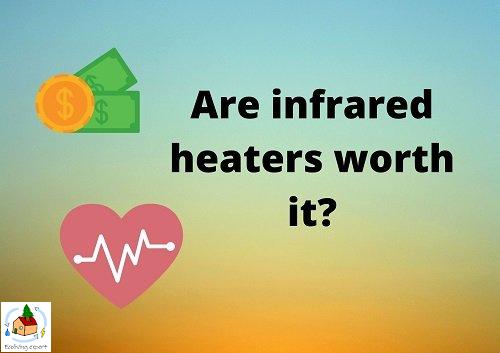Infrared heaters are worth purchasing over other heaters because they lower your energy costs for heating by 40%. They also improve indoor air quality by not circulating air and not emitting harmful compounds. Additionally, they do not pose a fire hazard and have a life expectancy of up to 10 years.
I personally own two infrared heating panels with a total of 1000 W and it was a huge game-changer for us in the living room + kitchen area. They were easy to install, provide almost instant heating, and practically do not take up any space. It is what started my journey leading up to the creation of this website.

How to determine if infrared heaters are worth it
Even though infrared heaters are some of the most expensive heaters on the market, there are many factors other than costs that determine if a space heater is worth buying. Taking into account costs as well as health and safety, infrared heaters are definitely worth it.
In this article, I will discuss the many factors that determine if an infrared space heater is worth buying over electric and gas-based space heaters. The following criteria will be taken into account:
- purchase costs
- energy use and efficiency
- running costs
- life expectancy
- total yearly costs
- health and safety
- type of heat produced
- conclusion
- personal experience
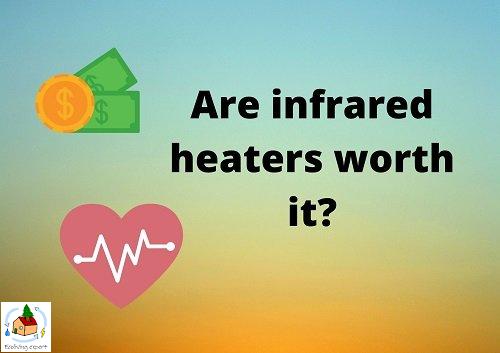
For a detailed look at all the pros and cons of infrared heating, I recommend checking out my article: Infrared heating pros and cons (and why I love it)
What does an infrared heater cost compared to other heaters?
The following table shows the cost range of infrared heaters, other electrical heaters, gas, and oil heaters based on amazon.com prices for a 1500W space heater. This will give you an indication of the costs of these heaters. However, for current prices and discounts, please check amazon.com. Prices can differ significantly based on extra features such as a thermostat, timer, and remote control.
For the purpose of comparing infrared heaters with other electric heaters, oil, and gas-fired heaters, I included two types of infrared heaters. I decided to include portable quartz heaters as well as heating panels since they differ significantly in various aspects such as life expectancy, use, and cost.
| Heater type | Purchase cost range for 1500 W |
|---|---|
| Infrared space heater | 75 – 140 $ |
| Infrared heating panel | 600 – 700 $ |
| Electrical heater | 24 – 80 $ |
| Gas heater | 40 – 180 $ |
| Oil heater | 45 – 103 $ |
How much energy does an infrared heater use compared to other heaters?
How much energy a space heater uses is almost a trick question. All heaters create warmth equal to their energy use. They are 100% efficient in turning their energy use into heat. So, for the purpose of comparing different space heaters, we need to look at heaters that have the same energy use. The most common space heaters use 1500 watts of energy and therefore produce 1500 watts of heat.
To be clear on the differences in energy use of these space heaters: gas-based heaters burn gas while infrared, electric, and oil-filled heaters all use electricity.
For an in-depth article about the energy use of infrared heaters per room type and size, please read my article: Infrared heaters energy use (costs, efficiency, W/sq. ft.)
Infrared heaters are more effective heaters
Normally, a space heater produces warm air. Therefore, their energy use precisely indicates how much heat they produce, and all space heaters are equally effective.
However, infrared heaters do not produce warm air. They produce infrared radiation that heats people and objects directly. Therefore, they are able to use a lot less energy for creating the same level of comfort.
Infrared heaters create sun-like radiation instead of warm air. Therefore, they require 40% less energy than other forms of heating to create the same level of comfort.
The following table shows the required wattage per square feet per room. This amount differs per room since, for example, the optimal bedroom temperature (65 °F/18 °C) is lower than the optimal living room temperature (68–72 °F/20–22 °C).
| Area | Infrared heating: wattage per sq. ft (0,1 m²) | Regular heating: wattage per sq. ft (0,1 m²) |
|---|---|---|
| Living room | 7 W | 10 W |
| Bedroom | 4.5 W | 6.3 W |
| Bathroom | 9.3 W | 13.3 W |
| Closed porch | 9.3 W | 13.3 W |
| Open outdoor area | 28 – 56 W | Warm air cannot heat an outdoor area |
As you can see in the table, a living room requires 10 watts of heating per square foot. This is true for conventional heating such as electric heating or gas-based heating. However, infrared heating can save massively on energy use as it is more focused and direct heating. If you are interested in why infrared heaters use less energy to create the same amount of heat, please read my article: Everything I learned about infrared heating efficiency.
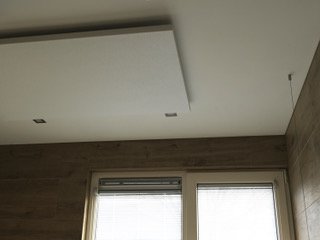
The running costs of infrared compared to electricity and gas-based heaters
Even though the energy use of infrared heaters is much lower than that of electricity or gas-fired heaters, the energy price differs significantly. Since infrared heating is much more efficient than regular electric heating, it is much cheaper to run. However, the electricity price is much higher than the gas price. Therefore, gas-fired heaters cost much less to run while using more energy.
These are the average prices of energy in the US:
- Average US price of electricity: 13.31 cents ($) per kWh
- Average US price of gas: 3.8 cents ($) per kWh
The following table shows the running costs of infrared heating vs conventional electric heating and gas-based heating.
| Time | costs infrared ($) | costs electricity ($) | costs gas ($) |
|---|---|---|---|
| One hour | 0.3 $ | 0.44 $ | 0.13 $ |
| Day (6 hours) | 1.84 $ | 2.64 $ | 0.75 $ |
| Week | 12.86 $ | 18.45 $ | 5.27 $ |
| Month (30 days) | 55.1 $ | 79.20 $ | 22.57 $ |
This table assumes an average 330 square-foot US living room that has medium insulation. The required amount of energy for infrared heating for this room is 2300 watts. The required amount of energy from electricity or gas is 3300 watts.
For more information about the running costs of infrared heaters compared to gas-based heating systems, I recommend reading my article: The real running costs of infrared heating (compared to gas)
Life expectancy and warranty of infrared heaters compared to other heaters
An important aspect other than costs is how long your heater lasts. This is determined by the type of heater, the quality of the heater, how well you maintain and how often you use it. For most heaters, life expectancy is quite difficult to determine because it depends on so many factors. However, I think the warranty on a product gives a good indication of how long you can expect your heater to last.
The following table gives a general indication of the life expectancy of the different types of heaters, as well as the expected warranty.
| Heater type | Life expectancy | Expected warranty |
|---|---|---|
| Infrared: portable quartz | 20.000 – 60.000 hours (2-7 years) | 3 years |
| Infrared: heating panel | 100.000 hours (11 years) | 10 years |
| Electric | 20.000 – 40.000 hours (2-5 years) | 1 – 5 years |
| Gas | 20.000 – 40.000 hours (2-5 years) | 1 – 3 years |
| Oil | 20.000 – 40.000 hours (2-5 years) | 1 – 3 years |
Yearly costs of infrared vs other heaters
The following table shows the warranty and price range of a 1500-watt heater of each type. This includes the expected purchase costs per year since you will likely need to purchase a new heater after the warranty has expired.
| Heater type | Warranty | Price range | Costs per year |
|---|---|---|---|
| Infrared: portable quartz | 3 years | 75 – 140 $ | 25 – 47 $ |
| Infrared: heating panel | 10 years | 600 – 700 $ | 60 – 70 $ |
| Electric | 1 – 5 years | 24 – 80 $ | 24 – 80 $ |
| Gas | 1 – 3 years | 40 – 180 $ | 40 – 180 $ |
| Oil | 1 – 3 years | 45 – 103 $ | 45 – 103 $ |
The costs per year are based on their warranty instead of life expectancy since you can be sure your heater will work the time you have a warranty. The life expectancy is often higher and will be an indication of how long you can use the heater when the warranty is expired.

Total yearly costs per heater type
The following table shows the costs of using the heaters for one year for 6 hours a day. This includes running costs and the costs of purchase.
| Heater type | Average costs per year (based on purchase cost and warranty) | Running costs per year | Total yearly costs |
|---|---|---|---|
| Infrared: portable quartz | 36 $ | 672 $ | 708 $ |
| Infrared: heating panel | 65 $ | 672 $ | 737 $ |
| Electric | 52 $ | 964 $ | 1016 $ |
| Gas | 110 $ | 274 $ | 384 $ |
| Oil | 74 $ | 964 $ | 1038 $ |
Clearly, gas-fired heaters are much cheaper taking into account purchase and running costs. Per month, gas-based heaters cost 32 $ and infrared quartz heaters cost 59 $. Health and safety aspects as well as the unique type of heat that infrared heaters produce are however not easily expressed in money.
Health and safety of infrared vs other heaters
Electrical heaters such as infrared heaters have a distinct advantage over fuel-burning heaters in that they are much safer. Electric and infrared heaters do not burn any fuel and therefore do not pose any risks related to the burning of fuel such as:
- Carbon monoxide release
- air pollutants release
- Fire hazard
- Gas leaks
Carbon monoxide hazard
Carbon monoxide (CO) is a safety concern that should be taken very seriously. CO can be released when burning fuels. Therefore, gas-fired heaters are a CO concern. CO exposure can have significant health effects from headaches to unconsciousness and death. For more information on carbon monoxide, please read my article: Do infrared heaters give off carbon monoxide? (different heaters, CO prevention).
Air pollution as a result of heating
There are several ways in which heaters can lead to poor indoor air quality. These are the release of air pollutants from the heater itself or indirect effects on air quality due to an increase in air circulation.
Burning fuel leads to an increase in air pollutants
Air pollutants are released every time anything gets burned. With the burning of gas, microscopic particles are released into the air. These particles pose a health hazard since they can harm lung tissue and cause a variety of symptoms including headaches, fatigue, and respiratory problems.
Air circulation stirs up dust and other air pollutants
Increased air circulation is another factor that negatively influences indoor air quality. Air movement stirs up particles such as dust and other air pollutants that have settled down on surfaces. In this way, they are re-entering the air and can be breathed in again.
So what causes air circulation? well, heating up the air. Warm air tends to rise, while cold air sinks. Therefore, when you turn on your gas heaters and start warming up the air, you will be creating air movement from the heater toward the ceiling. Eventually, the warm air starts to spread along the ceiling and cold air will descend down.
On the one hand, you want this process to happen because it eventually fills the entire room with warm air. But you will also massively increase air movement in your room, and therefore the recirculation of air pollutants. Infrared heaters do not have this problem because they are designed to transfer their heat directly instead of warming the air.
Indoor air quality is a topic I am passionate about and wrote many articles on this website. If you are interested in what causes indoor air pollution and how you can prevent it, I suggest starting with my article: The complete indoor air quality guide for your home.
Infrared heaters do not burn fuel and don’t increase air movement. Therefore, it is your best choice with regards to indoor air pollution.
Fire hazard of space heaters
Electric (infrared) heaters do not burn any fuel. Additionally, portable infrared heaters come with a safe casing, overheating protection, and tip-over protection. Therefore, they are a very safe choice and do not pose a fire hazard when used and installed properly. Proper use includes standing free from other objects (at least 3 feet), and not using it around flammable materials such as paints or fuels. For more information on safety, please read my article: Infrared heaters safety (fire, radiation, safe practices).
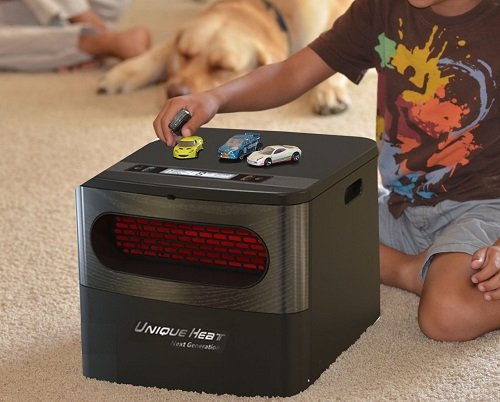
Gas-based heaters do pose a fire hazard because they are burning fuel and there is literally fire inside the heater. However, you can be sure any heater on the market has been thoroughly tested for safety. Therefore, when used properly according to the provided safety instructions, you should be fine. Make sure to maintain the heater so it is in good condition.
For gas heaters, there is an additional issue, namely the possibility of a gas leak. This is a very serious issue and requires you to keep the heater well-maintained and never leave it unattended.
Is infrared radiation safe?
Household infrared space heaters are perfectly safe and healthy. Although radiation might sound dangerous, infrared radiation is the exact same as the sun’s rays. They provide wonderful heat and are basically exactly perfect for human skin. For this reason, infrared radiative heating is used in some types of saunas as well as some forms of therapy.
For more in-depth information on infrared heating safety, I recommend reading my article: Infrared heaters safety (fire, radiation, safe practices).
Infrared heaters produce a different type of heat
The main difference between infrared heaters and other heaters is the type of heat they provide. Non-infrared heaters produce warm air. The warm air fills the entire room and then transfers its heat to the objects and people inside the room.
Infrared heaters work very differently. They are not designed to produce warm air (although they still produce about 10% warm air) but produce infrared radiation. This is very similar to sunrays. Sun rays travel millions of miles through space before hitting your skin and only then releasing their warmth. Infrared heaters work similarly. They emit infrared radiation that heats any person or object that is hit by the rays. This is called direct heating and requires much less energy for the same level of comfort.
If you want to read more about how infrared heaters work, and what their advantages are over warm-air heaters, please read my article: How do infrared panels work? A simple explanation.
For all the pros and cons of infrared heating, I recommend reading my article: Infrared heating pros and cons (personal experience).
Conclusion: infrared heaters are worth it
My calculation for yearly costs of the different types of heaters took into account the costs of purchase. Therefore, it is easy to see that a gas heater is much cheaper than any other option. Infrared heaters are in second place but cost almost twice as much.
However, costs are not the only factor in determining if purchasing an infrared heater is worth it. Health and safety are important factors, as well as the type of heat that is produced.
When taking into account all criteria and the unique properties of infrared heating I think infrared heaters are worth the extra 30 $ per month. In fact, I personally own two infrared heating panels and am loving them.
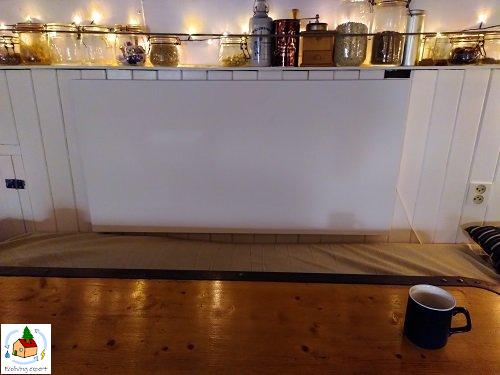
My experience with infrared panels
I currently live in a very poorly insulated space. Therefore, infrared heaters are a great option since they do not produce warm air that is lost quickly. I own two infrared heating panels which I use to heat my seating area and kitchen. You can read all about my experience with these heaters in my article: Infrared heating panels experience.
Next to infrared heaters, I use an electric space heater to provide warm air. I like this heater because it is easily portable to the room that needs temporary heating (mostly for construction jobs).
Where to purchase infrared heaters
I would suggest contacting a local store so you can get some professional advice if necessary. Otherwise, you can simply order them from amazon.com (and support me this way as I earn a small commission).
You can find several excellent infrared panels here. And you can find many more infrared heaters here.

